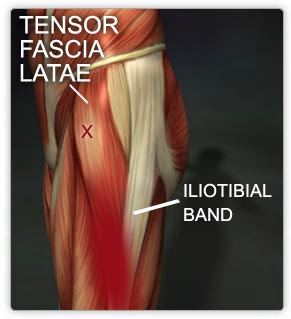Sunday, October 19, 2014
Tensor Fascia Latae
Tensor Fascia Latae
The tensor fasciae latae is a muscle with several functions to aid the hip. This muscle, approximately three fingers wide and located on the lateral side of the hip, is an abductor and internal rotator of the hip, and a hip flexor. As an abductor of the hip the TFL (tensor fascia Latae) aids in drawing a limb away from the body. The TFL works together with two other important muscles of the gluteal, gluteus medius and gluteus minimus. As an internal rotator of the hip, TFL works with a group of muscles that act to stabilize the hip. Gluteus minimus primary function is to stabilize the hip when walking or standing. TFL aids in the equalizing of the gluteus minimus and medius when an individual is standing or walking with the effect on the opposite of side of the TFL.
If the TFL becomes hindered, the rotation of the hip will feel a constraint and an additional burden will be placed on the TFL. Inhibition of the TFL will often radiate pain into the groin area.
Additionally, the hampering of the TFL may in turn cause pain in the psoas, rector femoris, adductors, and Sartorius’s muscles. This small but mighty muscle is important in keeping the hip flexors and gluteal functioning properly.
Another area that may be affected by TFL is the IT band. Strengthening the TFL before rolling out the Illiotibial Band will prove fruitless, unless strengthening the TFL occurs first. Find a physical therapist or a certified personal trainer to help secure the best exercises for strengthening this muscle, which will help decrease discomfort in so many areas of the hips and gluteal.
Some causes of the pain the TFL is sitting, driving, or exercising at a 90 degree angle for long periods of time. Other causes of TFL discomfort are sleeping in the fetal position or sleeping with feet elevated. Runners and walkers often experience pain in the IT band, which in turn radiates pain to the TFL. An individual may be overweight which also can increase the pain in the hip and TFL area.
The body is interconnected. Connecting muscles often refer pain and tenderness, when in fact the muscle that is being affected cannot be determined. Massage therapy can locate the muscle and surrounding muscles that are causing the pain. With proper palpitations and manipulation the client may feel relief within a few weeks if properly treated.
David Kent, L. N. (2012, February). Hip and Thigh Pain: The Tensor Fascia Latae Connection. Retrieved from Massage Today: http://www.massagetoday.com/mpacms/mt/article.php?id=14542
The Often Overlooked Tensor Fascia Latae. (2010). Retrieved from Neurokinetic Therapy: http://neurokinetictherapy.com/the-often-overlooked-tensor-fascia-lata
Subscribe to:
Post Comments (Atom)


No comments:
Post a Comment